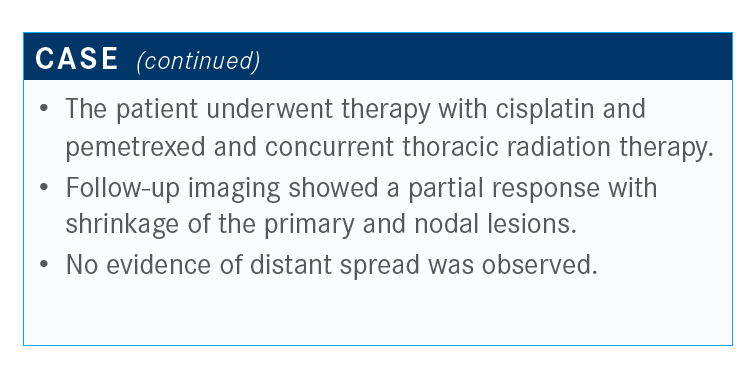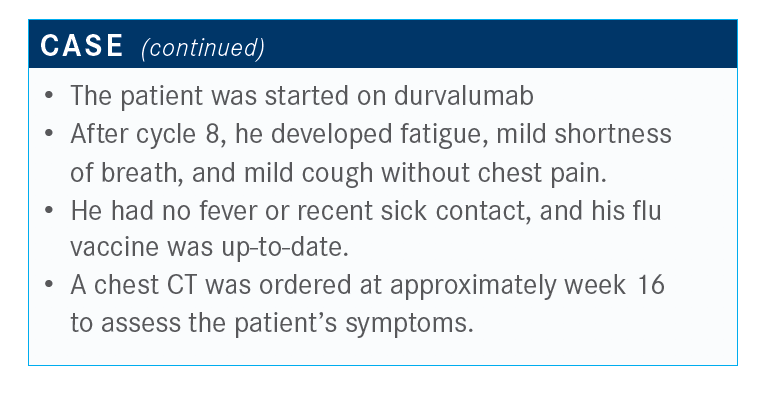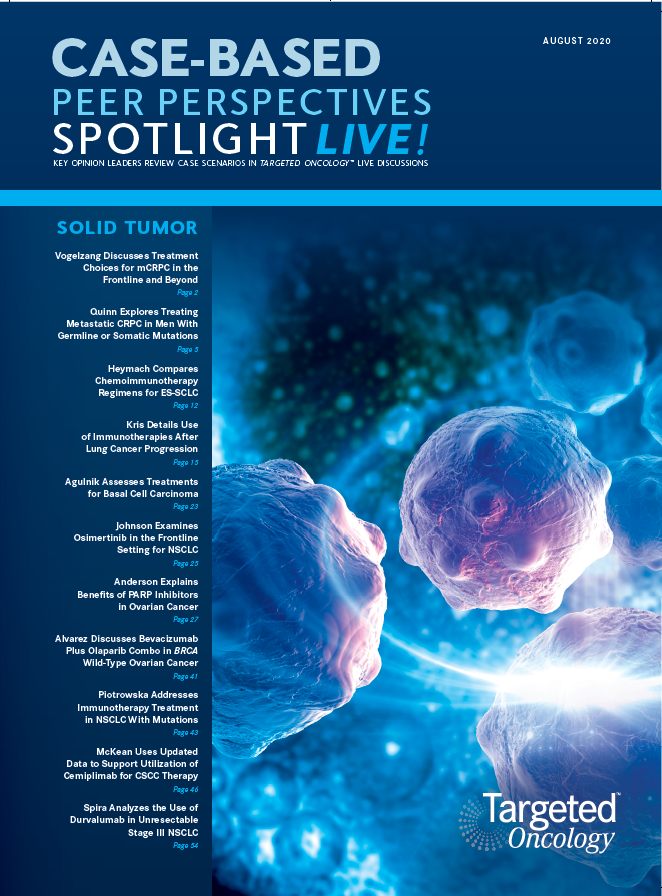Spira Analyzes the Use of Durvalumab in Unresectable Stage III NSCLC
Alex Spira, MD, PhD, director, Virginia Cancer Specialists, Phase I Trial Program, Fairfax, VA, discussed the use of durvalumab as treatment of a 63-year-old male with unresectable stage III non–small cell lung cancer.
Alex Spira, MD, PhD

Alex Spira, MD, PhD, director, Virginia Cancer Specialists, Phase I Trial Program, Fairfax, Virginia, discussed the use of durvalumab as treatment of a 63-year-old male with unresectable stage III non–small cell lung cancer.

Targeted Oncology™: How would you have handled this patient’s case?
SPIRA: With [a case] such as this, I would have done an endo-bronchial ultrasound because you probably wouldn’t have radiated the mediastinum if [there was no evidence of disease involvement]. There are some people who have 6-cm nodes in the subcarinal space. I think endo-bronchial ultrasound is more and more available. Five years ago, it was less available, but it’s becoming more available to everybody, based upon treatment patterns.
What portion of your patients with unresectable stage III non–small cell lung cancer receive concurrent chemoradiotherapy?
Chemoradiotherapy is the standard. There are some people who either come from a long distance or have bad enough pulmonary function that they can’t get it; there are some people who can’t tolerate it, or [the patient is too old].
Which therapies are available in this setting?
The standard chemotherapies [in the National Comprehensive Cancer Center guidelines include] the old SWOG [NCT00002642] regimen of cisplatin and etoposide with concurrent radiotherapy, carboplatin, and pemetrexed [Alimta] at standard dose of every 3 weeks. It’s interesting—this is 12 weeks of therapy, although some will only do 6 weeks. Cisplatin and pemetrexed every 3 weeks for 3 cycles [is an option], plus or minus pemetrexed afterwards. Then there’s weekly carboplatin and paclitaxel.1
With all these [treatment options], even though these are [recommended] in the guidelines, I think everybody has changed [them] a little bit. I know there are people who just give cisplatin and pemetrexed during radiation, or carboplatin and pemetrexed during radiation, and nothing afterward.
I use weekly carboplatin and paclitaxel; it’s what I’ve always used. It also makes [treating] easier because if patients get a fine-needle aspiration, they sometimes [come back with a] report of poorly differentiated [cells]. The report can’t tell you if it’s squamous or nonsquamous disease, and [there isn’t] enough [of the sample] for immunohistochemistry testing. So, I think you’re covering your bases for all of it [with carboplatin and paclitaxel]. I know some people like the old SWOG regimen of cisplatin and etoposide. I just can’t get that out of my mind that that’s a pretty toxic regimen, so that’s not what I like to use.

What was the design of the PACIFIC trial (NCT02125461)?
It was a large phase 3 study; it was double-blind, placebo-controlled, classic multicenter and international trial, which we don’t see much of anymore.2 This was designed for patients with stage III, locally advanced, unresectable lung cancer, who did not progress following definitive platinum-based chemoradiotherapy greater than or equal to 2 cycles of therapy.
[Patients could be] 18 or older, with a performance status of 0 or 1, and a life expectancy of greater than 12 weeks. If they didn’t have a life expectancy of greater than 12 weeks, I’m not sure they would have received chemoradiation. Archived tissue was collected, and it was an all-comers population. Randomization was 2:1 to durvalumab at the standard dose of 1 mg/kg every 2 weeks for 12 months versus placebo.
It had the standard end points of progression-free survival [PFS] and overall survival [OS]; secondary end points included response rate, which I always find questionable; duration of the response; safety; and patient-reported outcomes.
Please describe the updated efficacy for patients in this trial.
The updated 12-month PFS rate was markedly better, 55.7% with durvalumab versus 34.4% with placebo. [It was similar] at 18 months. There was a median PFS of 17.2 versus 5.6 months, which in oncology is a grand slam, especially in stage III disease. I [never] thought I’d have a study [that evaluated] all-comers with stage III disease where patients would have 55% 1-year PFS, which is almost beyond remarkable, with a hazard ratio of 0.51 [95% CI, 0.41-0.63]. This was published in 2018, clearly a positive study, and led to the FDA approval [of durvalumab].3
Looking at the PFS by subgroup, a common question that comes up is, “How does histology [play a role]?” It doesn’t; patients with both squamous and nonsquamous disease benefited.4 Patients with EGFR mutated disease had an unstratified hazard ratio of 0.76 with a wide range [95% CI, 0.35-1.64].
Regarding PD-L1 status, patients showed significant PFS across the board for a status of greater than 25%, less than 25%, and/or unknown. Remember, the patients did not have to have this tested beforehand; it was all done retroactively on tissue, so there were a fair number of unknowns. I think it doesn’t matter what histology the patients have; it does not necessarily matter what their PD-L1 status is for PFS.
In the subgroup analysis, there appears to be an improvement for starting in fewer than 14 days after the completion of chemoradiotherapy versus 14 days or more, with a hazard ratio of 0.39 versus 0.63, respectively. In the original PACIFIC study, patients could have [waited] up to 42 days, so there was a longer window. I think part of it is probably driven by the fact that some patients who did better will just do better. Most of us think about starting durvalumab as soon as the patient is medically fit.
There’s a patient population that is just tired. After daily radiation for 4.5 weeks, sometimes people need a break. They have dysphasia; they’ve lost some weight. You’re more likely to give them a little bit of time—at least that’s how I do it. I will say 14 days is tough for most of my patients. I try to [treat] them within a month. I think that’s a reasonable thing. But I think what this tells us is that sooner is better, and that’s the best way of viewing it for now.
Whether that’s a true function of sooner being better or just patient performance status is unknown, especially at the time of completion of the therapy, which is what we’re talking about. Thinking about it sooner rather than later is better.5
Some of the subgroup analyses I find interesting, as well.2 This subgroup analysis was not in the original protocol. There was clearly improvement across the board. With OS, there were slightly different numbers. In the greater than 25% PD-L1 score using a different assay—not the standard 22C3 assay that we typically think of—the numbers are within reason; there was clearly a benefit. But, interestingly, for patients who had disease with PD-L1 less than 25%, the OS crossed the midline.
There was a post hoc analysis, meaning we shouldn’t abide by it, but we should think about it. Fewer than 60% of patients had adequate tissue for PD-L1 assessment.5 It was small numbers, so the PD-L1 status of 0% was only in about 20% of patients. The hazard ratio at 3-year follow-up dropped from 1.36 to 1.14, and it’s hypothesis-generating.
Do you have concerns when treating patients with PD-L1 status of 0% with durvalumab?
The only thing I think about is if patients start to have some adverse effects [AEs]. [Treating patients’] pneumonitis is an easy call, but patients who are older may have myalgias and may start complaining in months 9 to 12. If I know their PD-L1 status is 0, I might have more of a tendency to back off [with durvalumab]. We don’t know the optimal duration; we will probably never know that. This is one of the reasons I check PD-L1 status, just in case patients start to experience toxicity after a while. I might be completely wrong, because, at the end of the day, you might not need more than 6 months. We give people 12 months, but [there’s a] reason to think about that.
What was the toxicity profile with durvalumab?
[It was a] pretty safe drug…across the board.4 There were lots of patients with grade 3/4 AEs, although I imagine many of those were lingering from chemoradiation. Interestingly, 24% [of patients on durvalumab had any-grade] immune-related AEs, and 8% of patients on placebo had immune-related AEs.
With AEs of interest, there was an increase in pneumonitis, which is what one would expect. I think when you look at some of these data that focus on patients getting chemoradiation, if the radiologist said they had pneumonitis and pneumonia in the radiating field, it probably [would be] captured as an AE, rather than being a true event. We see this all the time, depending on how the data are collected. But, nevertheless, [there was an] increase in pneumonitis overall and a slight increase in pneumonia. Overall, [durvalumab was] well tolerated.
How do the NCCN guidelines recommend using this agent?
NCCN guidelines…[suggest that] durvalumab, a category 1 treatment, be given every 2 weeks for up to 12 months.1 NCCN deleted recommendations to add an additional 2 cycles of fulldose chemotherapy. Based upon all the data, there’s not much of a role for 4 cycles of chemotherapy, which a lot of people were prescribing. That was not allowed on the study, and I think most people I know don’t do it, although there are still a few physicians who insist on consolidation docetaxel. You can give consolidation chemotherapy to patients who are not receiving durvalumab for medical contraindications or other reasons. I’m not a big fan, and I stopped doing that a few years ago. I do know of other people doing it.
If using durvalumab, the NCCN guidelines do not recommend 2 cycles of chemotherapy. This is following the PACIFIC study word for word, which I think is reasonable. It gets back into the debate that patients with stage III disease receive less chemotherapy than patients with stage I or II disease.

What is your approach towards pneumonitis and management for patients receiving a single
checkpoint inhibitor?
The ultimate question is whether you rechallenge a patient after [a single checkpoint inhibitor]. That’s always the million-dollar question. For me, I look at the grading of it and how much more they have to go. So, if they’re 9 or 10 months into it, and they’ve had grade 2 pneumonitis, I probably would stop it. If they’re 2 months into it, and it’s grade 1/2, I might continue on it. I think one of the key things is if it’s the asymptomatic variety of pneumonitis, our radiologists are good at noticing it when the patients are not having any symptoms. You look at it, and you have to remind people that it’s benign, and they probably don’t need to be treated; it’s just a radiographic finding. I think now they’ll all probably say it’s [coronavirus disease 2019], so get tested.
For me, this is one of the reasons I check PD-L1 status. It helps me decide if a patient, based upon the severity, should be continued on durvalumab. For grade 3/4 pneumonitis, permanently discontinue [this therapy]; these patients are pretty sick.
References:
1. NCCN Clinical Practice Guidelines in Oncology. Non–small cell lung cancer; version 6.2020. National Comprehensive Cancer Network. Published June 15, 2020. Accessed July 24, 2020. https://bit.ly/30NKRrb
2. Antonia SJ, Villegas A, Daniel D, et al; PACIFIC Investigators. Overall survival with durvalumab after chemoradiotherapy in stage III NSCLC. N Engl J Med. 2018;379(24):2342-2350. doi:10.1056/NEJMoa1809697
3. FDA approves durvalumab after chemoradiation for unresectable stage III NSCLC. U.S. Food & Drug Administration. Updated February 20, 2018. Accessed July 24, 2020. https://bit.ly/2OZEBXv
4. Antonia SJ, Villegas A, Daniel D, et al; PACIFIC Investigators. Durvalumab after chemoradiotherapy in stage III non–small-cell lung cancer. N Engl J Med. 2017;377(20):1919-1929. doi:10.1056/NEJMoa1709937
5. Gray JE, Villegas AE, Daniel DB, et al. Three-year overall survival update from the PACIFIC trial. J Clin Oncol. 2019;37(suppl 15):8526. doi:10.1200/JCO.2019.37.15_suppl.8526
